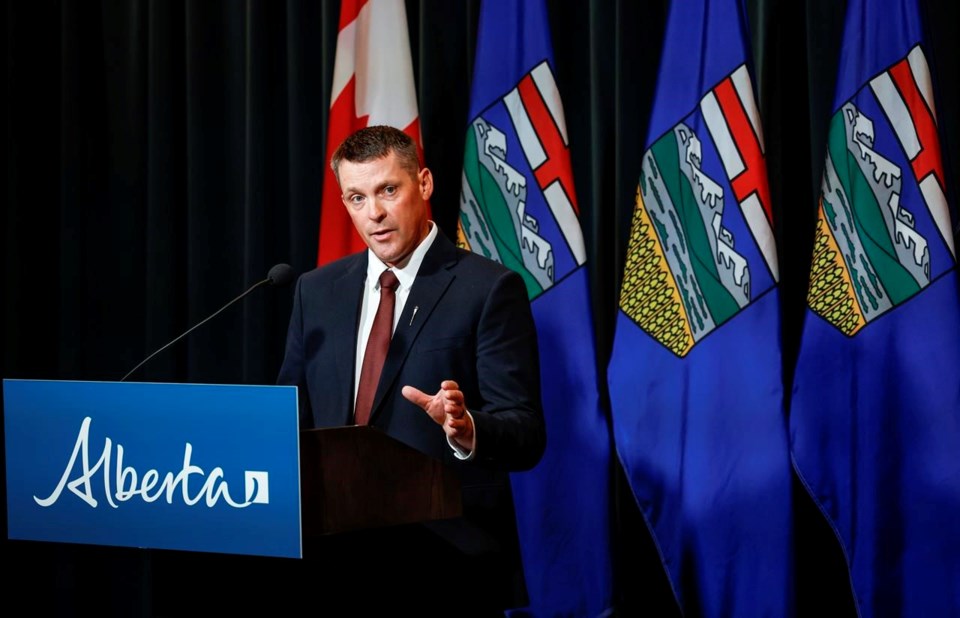EDMONTON — The Alberta government is again considering using the Quebec investment model for a possible provincial pension plan, less than a week after Finance Minister Nate Horner announced the Quebec option had been scrapped.
The Quebec model has been a point of contention amid concerns that Alberta’s pension reserves could be at risk through politically driven investment in dicey pet projects and sweetheart deals.
The Opposition NDP said Tuesday the policy confusion shows Premier Danielle Smith’s United Conservative Party government would be challenged to “organize a two-car parade.”
Savannah Johannsen, Horner's spokesperson, confirmed in a statement the Quebec model is back on the table.
“Albertans have the final say on the mandate of the investment manager,” Johannsen said Monday in a statement.
“The engagement panel (currently gathering public feedback on the pension proposal) will hear whether Albertans want that mandate to be solely focused on maximizing returns or whether it should have a dual mandate that also focuses on economic development in Alberta, similar to Quebec’s pension manager.”
Johannsen said regardless of the investment mandate, politicians will not be calling the shots.
“We want to make it clear that (Alberta pension plan) investment decisions will not be made by the government,” said Johannsen.
“That’s why new legislation this fall, if passed, will guarantee all assets transferred from the CPP will only be used to set up and operate an Alberta pension plan. This will prohibit the government from using pension money for other priorities.”
The structure and investment priorities of an Alberta plan were one of the many options Smith asked Albertans to consider when she released a third-party report Sept. 21 to launch consultations on whether the province should create a stand-alone pension plan.
The report, by pension analyst LifeWorks, calculates an Alberta plan could deliver lower contribution rates and higher returns. It also estimates the province is entitled to 53 per cent of the $575-billion CPP fund.
Quebec has not joined the CPP since the fund was created in the 1960s and runs its own pension fund.
The Quebec fund has a dual mandate to not only maximize investment returns but also to invest in the provincial economy.
That has led to concerns that if Alberta follows suit, its fund could make questionable investment deals, including doubling down on oil and gas in the age of ascendant renewables and put the viability of the fund at risk.
On the Ryan Jespersen online news talk show last Thursday, Horner said he has heard those concerns and the Quebec model for Alberta is a non-starter.
“We don't believe in going down the model that Quebec has,'' Horner said.
"We want everyone to know clearly that this (Alberta investment model) will be for the operation of the pension plan.''
Horner said legislation would be introduced this fall to effectively cancel out the Quebec model and spell out that "any (pension) assets used would only be used for a pension plan.''
Johannsen, asked Tuesday to explain the policy reversal, did not immediately return a request for comment.
The issue of political interference in an Alberta pension plan came up Monday night when the pension engagement panel, led by former provincial treasurer Jim Dinning, heard from callers in the first of five telephone town hall sessions.
A caller identified as Allan told the panel there needs to be clear rules on maximizing returns to ensure "we wouldn’t run into these kind of political boutique investments that seem from time to time (to) become attractive, which really are not properly considered investments.”
Another caller identified as Harvey said he is concerned government priorities will become the pension fund’s priorities, particularly as it relates to oil and gas development.
Harvey said he worries, “given the position of the Alberta government on renewable energy, where they basically stopped the major investments in it for six or eight months, that that sort of ideology would somehow find its way into (pension) investment criteria. Hopefully it would not.”
The UCP government has shown in the past it will step up with public funds to assist its bedrock oil and gas industry.
In 2020, Alberta taxpayers lost more than $1 billion in a provincial financing and loan package aimed at reviving the cross-border Keystone XL pipeline.
Opposition NDP finance critic Shannon Phillips said the confusion over Horner’s comment is telling.
“I don't think these guys can organize a two-car parade,” said Phillips in an interview.
“They don't know what they're doing in there.
"These are the last people that we want to give the keys to hundreds of billions of dollars of our money that has been coming off our paycheques since we were teenagers.”
Dinning’s panel is to make a recommendation in the spring on whether there is a public appetite to leave the CPP. If so, Smith said she will call a referendum on the question.
This report by The Canadian Press was first published Oct. 17, 2023.
Dean Bennett, The Canadian Press



